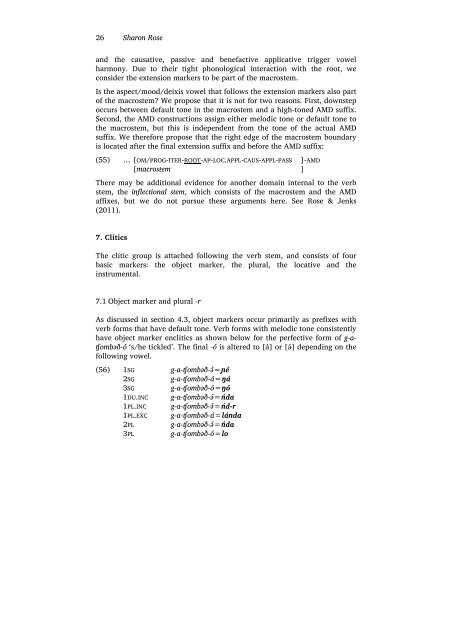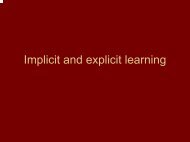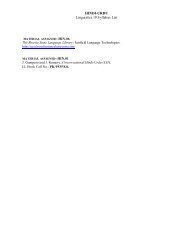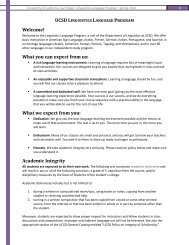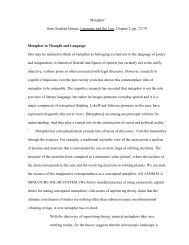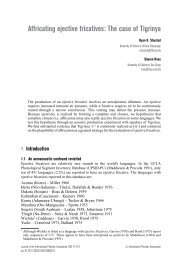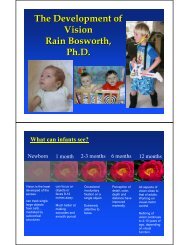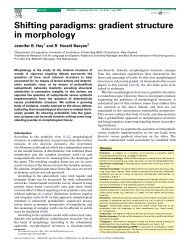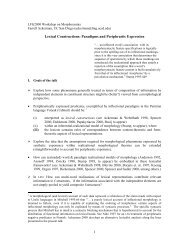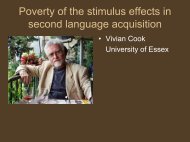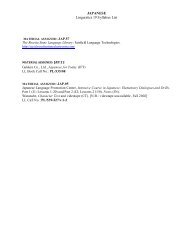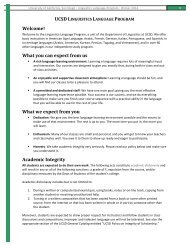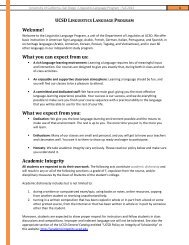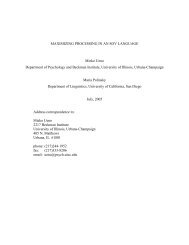The morphological structure of the Moro verb Sharon Rose
The morphological structure of the Moro verb Sharon Rose
The morphological structure of the Moro verb Sharon Rose
Create successful ePaper yourself
Turn your PDF publications into a flip-book with our unique Google optimized e-Paper software.
26<br />
<strong>Sharon</strong> <strong>Rose</strong><br />
and <strong>the</strong> causative, passive and benefactive applicative trigger vowel<br />
harmony. Due to <strong>the</strong>ir tight phonological interaction with <strong>the</strong> root, we<br />
consider <strong>the</strong> extension markers to be part <strong>of</strong> <strong>the</strong> macrostem.<br />
Is <strong>the</strong> aspect/mood/deixis vowel that follows <strong>the</strong> extension markers also part<br />
<strong>of</strong> <strong>the</strong> macrostem? We propose that it is not for two reasons. First, downstep<br />
occurs between default tone in <strong>the</strong> macrostem and a high-toned AMD suffix.<br />
Second, <strong>the</strong> AMD constructions assign ei<strong>the</strong>r melodic tone or default tone to<br />
<strong>the</strong> macrostem, but this is independent from <strong>the</strong> tone <strong>of</strong> <strong>the</strong> actual AMD<br />
suffix. We <strong>the</strong>refore propose that <strong>the</strong> right edge <strong>of</strong> <strong>the</strong> macrostem boundary<br />
is located after <strong>the</strong> final extension suffix and before <strong>the</strong> AMD suffix:<br />
(55) … [OM/PROG-ITER-ROOT-AP-LOC.APPL-CAUS-APPL-PASS ]-AMD<br />
[macrostem ]<br />
<strong>The</strong>re may be additional evidence for ano<strong>the</strong>r domain internal to <strong>the</strong> <strong>verb</strong><br />
stem, <strong>the</strong> inflectional stem, which consists <strong>of</strong> <strong>the</strong> macrostem and <strong>the</strong> AMD<br />
affixes, but we do not pursue <strong>the</strong>se arguments here. See <strong>Rose</strong> & Jenks<br />
(2011).<br />
7. Clitics<br />
<strong>The</strong> clitic group is attached following <strong>the</strong> <strong>verb</strong> stem, and consists <strong>of</strong> four<br />
basic markers: <strong>the</strong> object marker, <strong>the</strong> plural, <strong>the</strong> locative and <strong>the</strong><br />
instrumental.<br />
7.1 Object marker and plural -r<br />
As discussed in section 4.3, object markers occur primarily as prefixes with<br />
<strong>verb</strong> forms that have default tone. Verb forms with melodic tone consistently<br />
have object marker enclitics as shown below for <strong>the</strong> perfective form <strong>of</strong> g-aʧombəð-ó<br />
‘s/he tickled’. <strong>The</strong> final -ó is altered to [á] or [ə́] depending on <strong>the</strong><br />
following vowel.<br />
(56) 1SG g-a-ʧombəð-ə́=ɲé<br />
2SG g-a-ʧombəð-á=ŋá<br />
3SG g-a-ʧombəð-ó=ŋó<br />
1DU.INC g-a-ʧombəð-ə́=ńda<br />
1PL.INC g-a-ʧombəð-ə́=ńd-r<br />
1PL.EXC g-a-ʧombəð-á=lánda<br />
2PL g-a-ʧombəð-ə́=ńda<br />
3PL g-a-ʧombəð-ó=lo


